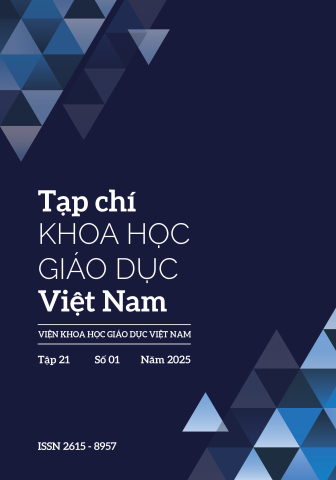[1] Cassidy, S. (2004). Learning styles: An overview of theories, models, and measures. Educational psychology, 24(4), 419-444. https://doi. org/10.1080/01443410420.
[2] Conner, C. (2003). Learning styles and school improvement. Improving Schools, 6(1), 51-65. https://doi.org/10.1177/136548020300600109
[3] Deng, R., Benckendorff, P., & Gao, Y. (2022). Limited usefulness of learning style instruments in advancing teaching and learning. The International Journal of Management Education, 20(3), 100686. https://doi.org/10.1016/j.ijme.2022.100686
[4] Dennehy, E. (2014). Learning approaches and cultural influences: A comparative study of Confucian and western-heritage students. Journal of Further and Higher Education. https://doi.org/10.1080/030987 7X.2013.869561.
[5] Dewey, J. (1938). Experience and education. Kappa Delta Pi.
[6] Ezzaim, A., Dahbi, A., Aqqal, A., & Haidine, A. (2024). AI-based learning style detection in adaptive learning systems: a systematic literature review. Journal of Computers in Education, 1-39. https://doi. org/10.1007/s40692-024-00328-9.
[7] Fleming, N. D. (2012). Some facts about VARK. Retrieved from https://vark-learn.com/wp-content/uploads /2014/08/Some-Facts-About-VARK.pdf
[8] Fleming, N. D., & Mills, C. (1992). Not another inventory, rather a catalyst for reflection. To Improve the Academy: A Journal of Educational Development, 11, 137-155. https://doi.org/10.1002/j.2334-4822.1992. tb00213.x
[9] Gardner, H. (1983). Frames of mind: The theory of multiple intelligences. Basic Books
[10] Honey, P., & Mumford, A. (2000). The learning styles helper’s guide. Peter Honey Publications
[11] Kolb, A. Y., & Kolb, D. A. (2014). Experiential learning: Experience as the source of learning and development (2nd ed.). Pearson
[12] Kolb, D. A. (1984). Experiential learning: Experience as the source of learning and development. Prentice Hall
[13] Kolb, D. A. (2013). The Kolb Learning Style Inventory 4.0: A comprehensive guide to the theory, psychometrics, research on validity and educational applications. Hay Group
[14] Kolb, D. A. (2015). Experiential learning: Experience as the source of learning and development. FT Press.
[15] Kurt, L. (1946). Action research and minority problems. Journal of Social Issues, 2(4), 34-46. https://doi. org/10.1111/j.1540-4560.1946.tb02295.x.
[16] Kurt, L. (1951). Field theory in social science. University of Chicago Press.
[17] Litzinger, T. A., Lee, S. H., Wise, J. C., & Felder, R. M. (2007). A psychometric study of the Index of Learning Styles. Journal of Engineering Education, 96(4), 309-319. https://doi.org/10.1002/j.2168-9830.2007. tb00941.x.
[18] Mousavi, S. K., Javadzadeh, A., Hasankhani, H., & Parizad, Z. A. (2024). Relationship between learning styles and clinical competency in nursing students. BMC Medical Education, 24(1), 469. https://doi.org/10.1186/s12909-024-05432-z
[19] Newton, P. M. (2015). The learning styles myth is thriving in higher education. Frontiers in Psychology, 6, 1908. https://doi.org/10.3389/fpsyg. 2015.01908.
[20] Newton, P. M., & Miah, M. (2017). Evidence-based higher education – Is the learning styles ‘myth’ important? Frontiers in Psychology, 8, 444. https:// doi.org/10.3389/fpsyg.2017.00444.
[21] Pashler, H., McDaniel, M., Rohrer, D., & Bjork, R. (2008). Learning styles: Concepts and evidence. Psychological science in the public interest, 9(3), 105-119. https://doi.org/10.1111/j.1539-6053.2009. 01038.x.
[22] Piaget, J. (1952). The origins of intelligence in children. International University Press.
[23] Shabani, K., Khatib, M., & Ebadi, S. (2010). Vygotsky’s zone of proximal development: Instructional implications and teachers’ professional development. English Language Teaching, 3, 237- 248. https://doi.org/10.5539/elt.v3n4p237.
[24] Srivastava, D. K., & Shah, H. (2022). Do learning styles of undergraduate and postgraduate students in B-schools differ? Insights and implications. Journal of Education for Business, 97(3), 168-175. https://doi. org/10.1080/08832323.2021.1910114
[25] Sun, Q. (2008). Confucian educational philosophy and its implication for lifelong learning and lifelong education. International Journal of Lifelong Education, 27(5), 559–578. https://doi. org/10.1080/01411920802343269
[26] Thongchotchat, V., Kudo, Y., Okada, Y., & Sato, K. (2023). Educational recommendation system utilizing learning styles: A systematic literature review. IEEE Access, 11, 8987-8998.
[27] Van Der Stuyf, R. R. (2002). Scaffolding as a teaching strategy. Adolescent Learning and Development, 52(3), 5-18.
[28] Whitman, G. M. (2023). Learning styles: Lack of research-based evidence. The Clearing House: A Journal of Educational Strategies, Issues and Ideas, 96(4), 111-115. https://doi.org/10.1080/00098655.20 23.2203891.
[29] Willingham, D. T., Hughes, E. M., & Dobolyi, D. G. (2015). The scientific status of learning styles theories. Teaching of Psychology, 42(3), 266–271. https://doi.org/10.1177/0098628315589505.


